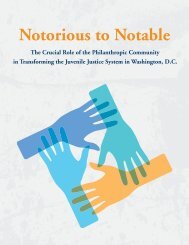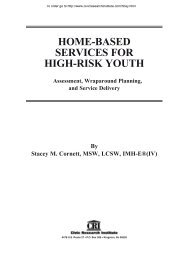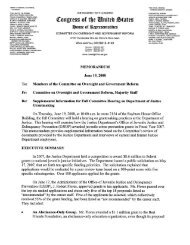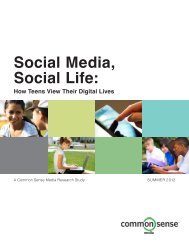Higher Education: Gaps in Access and Persistence Study
Higher Education: Gaps in Access and Persistence Study
Higher Education: Gaps in Access and Persistence Study
Create successful ePaper yourself
Turn your PDF publications into a flip-book with our unique Google optimized e-Paper software.
Executive Summary<br />
Numerous studies, <strong>in</strong>clud<strong>in</strong>g those of the National Center<br />
for <strong>Education</strong> Statistics (NCES), have documented<br />
persistent gaps between the educational atta<strong>in</strong>ment of<br />
White males <strong>and</strong> that of Black, Hispanic, American<br />
Indian/Alaska Native, <strong>and</strong> Native Hawaiian/Pacific<br />
Isl<strong>and</strong>er males. Further, there is evidence of grow<strong>in</strong>g<br />
gaps by sex with<strong>in</strong> these racial/ethnic groups, as females<br />
participate <strong>and</strong> persist <strong>in</strong> education at higher rates than<br />
their male counterparts (Aud, Fox, <strong>and</strong> KewalRamani<br />
2010; Aud et al. 2011). In the <strong>in</strong>terest of formulat<strong>in</strong>g<br />
policies to address these gaps, Congress directed the<br />
U.S. Department of <strong>Education</strong> to produce a report<br />
document<strong>in</strong>g the gaps <strong>in</strong> access to <strong>and</strong> completion of<br />
higher education by m<strong>in</strong>ority males <strong>and</strong> to outl<strong>in</strong>e<br />
specific policies that can help address these gaps (<strong>Higher</strong><br />
<strong>Education</strong> Opportunity Act, H.R. 4137, 110th Cong.<br />
§1109, 2008). NCES was directed to produce the <strong>Higher</strong><br />
<strong>Education</strong>: <strong>Gaps</strong> <strong>in</strong> <strong>Access</strong> <strong>and</strong> <strong>Persistence</strong> <strong>Study</strong>, a statistical<br />
report that documents the scope <strong>and</strong> nature of the gaps by<br />
sex <strong>and</strong> by race/ethnicity.<br />
The primary focus of the <strong>Higher</strong> <strong>Education</strong>: <strong>Gaps</strong><br />
<strong>in</strong> <strong>Access</strong> <strong>and</strong> <strong>Persistence</strong> <strong>Study</strong> is to exam<strong>in</strong>e gaps <strong>in</strong><br />
educational participation <strong>and</strong> atta<strong>in</strong>ment between<br />
male Blacks, Hispanics, Native Hawaiians/Pacific<br />
Isl<strong>and</strong>ers, <strong>and</strong> American Indians/Alaska Natives <strong>and</strong><br />
their female counterparts <strong>and</strong> to exam<strong>in</strong>e gaps between<br />
males <strong>in</strong> these racial/ethnic groups <strong>and</strong> White males.<br />
The secondary focus of the report is to exam<strong>in</strong>e overall<br />
sex <strong>and</strong> racial/ethnic differences. In addition to these<br />
descriptive <strong>in</strong>dicators, this report also <strong>in</strong>cludes descriptive<br />
multivariate analyses of variables that are associated<br />
with male <strong>and</strong> female postsecondary attendance <strong>and</strong><br />
atta<strong>in</strong>ment.<br />
Postsecondary attendance rates are generally lower for<br />
youth from lower socioeconomic backgrounds <strong>and</strong><br />
those from various racial/ethnic groups (e.g., Blacks <strong>and</strong><br />
Hispanics) when compared to Whites <strong>and</strong> Asians (Aud<br />
et al. 2011). In 2010, as <strong>in</strong> every year s<strong>in</strong>ce 1980, a lower<br />
percentage of male than female 18- to 24-year-olds were<br />
enrolled either <strong>in</strong> college or graduate school (39 vs. 47<br />
percent). This pattern was also observed for Whites (43<br />
vs. 51 percent), Blacks (31 vs. 43 percent), Hispanics (26<br />
vs. 36 percent), American Indians (24 vs. 33 percent),<br />
<strong>and</strong> persons of two or more races (40 vs. 49 percent). In<br />
addition to college enrollment differences, there are gaps<br />
<strong>in</strong> postsecondary atta<strong>in</strong>ment for males <strong>and</strong> females. For<br />
<strong>in</strong>stance, among first-time students seek<strong>in</strong>g bachelor’s<br />
degrees who started full time at a 4-year college <strong>in</strong> 2004,<br />
a higher percentage of females than males completed<br />
bachelor’s degrees with<strong>in</strong> 6 years (61 vs. 56 percent)—a<br />
pattern that held across all racial/ethnic groups.<br />
This report will document the scope <strong>and</strong> nature of a<br />
number of differences between sex <strong>and</strong> racial/ethnic<br />
groups <strong>in</strong> education preparation <strong>and</strong> achievement as<br />
well as differences <strong>in</strong> postsecondary access, persistence,<br />
<strong>and</strong> atta<strong>in</strong>ment between males <strong>and</strong> females with<strong>in</strong> <strong>and</strong><br />
across racial/ethnic groups. The report presents <strong>in</strong>dicators<br />
that <strong>in</strong>clude the most recently available, nationally<br />
representative data from NCES, other federal agencies,<br />
<strong>and</strong> selected items from the ACT <strong>and</strong> the College Board.<br />
The report draws on multiple sources that represent<br />
different years <strong>and</strong> different populations.<br />
Demographic Context<br />
Children <strong>in</strong> Poverty <strong>and</strong> Language M<strong>in</strong>orities<br />
In 2010, some 21 percent of children under age 18 were<br />
liv<strong>in</strong>g <strong>in</strong> poverty, <strong>and</strong> the poverty rate for children liv<strong>in</strong>g<br />
with a female parent with no spouse present was<br />
44 percent. The poverty rate for children liv<strong>in</strong>g with<br />
a female parent with no spouse present was higher for<br />
American Indian children (53 percent) than for children<br />
of all other racial/ethnic groups (with the exception of<br />
Black <strong>and</strong> Hispanic children). There were no measurable<br />
differences <strong>in</strong> male versus female poverty rates for children<br />
liv<strong>in</strong>g with a female parent with no spouse present.<br />
Also, <strong>in</strong> 2010, some 11.8 million children ages 5 to<br />
17 (about 22 percent of the school-age population)<br />
spoke a language other than English at home (2.7 million<br />
speak<strong>in</strong>g English with difficulty). The percentage who<br />
spoke a language other than English at home <strong>and</strong> spoke<br />
English with difficulty was higher for Hispanics<br />
(16 percent) <strong>and</strong> Asians (15 percent) than for Alaska<br />
Natives (7 percent), Native Hawaiians/Pacific Isl<strong>and</strong>ers<br />
(5 percent), American Indians (2 percent), children of two<br />
or more races (2 percent), Whites (1 percent), <strong>and</strong> Blacks<br />
(1 percent). No measurable differences were observed<br />
between males <strong>and</strong> females overall. However, higher<br />
percentages of Asian <strong>and</strong> Hispanic males (16 percent each)<br />
spoke a language other than English at home <strong>and</strong> spoke<br />
English with difficulty than females (14 <strong>and</strong> 15 percent,<br />
respectively) <strong>in</strong> their racial/ethnic group. In addition, a<br />
higher percentage of Hispanic school-age children born<br />
outside of the United States spoke a non-English language<br />
at home <strong>and</strong> spoke English with difficulty than did their<br />
counterparts born with<strong>in</strong> the United States (35 vs.<br />
13 percent).<br />
Parents’ <strong>Education</strong>al Atta<strong>in</strong>ment <strong>and</strong><br />
Involvement <strong>in</strong> <strong>Education</strong><br />
In 2010, about 11 percent of children between the ages<br />
of 6 <strong>and</strong> 18 lived <strong>in</strong> a household where neither parent<br />
had earned at least a high school credential (either a<br />
diploma or an equivalency credential such as a General<br />
<strong>Education</strong>al Development [GED] certificate). The<br />
percentage of children with parents who had not earned<br />
a high school credential was 11 percent for both males<br />
<strong>and</strong> females. Also, no measurable differences by sex<br />
with<strong>in</strong> racial/ethnic groups were found at any of the<br />
three levels of educational atta<strong>in</strong>ment exam<strong>in</strong>ed (less<br />
than high school completion, high school completion,<br />
Executive Summary<br />
Executive Summary v












